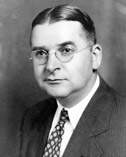
Karl Schmidt
June 19, 1890 - September 26, 1957
|
Scientific Discipline: Cellular and Developmental Biology Membership Type:
Member
(elected 1956)
|
Karl Schmidt is known for his work on the classification of amphibians and reptiles. He made major contributions to the field of zoology and ecology by naming more than 200 species and working out a modern classification system. He also proposed an applicable mechanism of evolution of the zoogeographic relation of organisms that takes into account geological evidence of land connections between the continents. He wrote the well-known book, Living Reptiles of the World, and more than 200 other books and articles.
Schmidt earned his BA degree from Cornell University in 1916. He then worked as a scientific assistant in herpetology at the American Museum of Natural History. In 1922 he left New York for Chicago to serve as the assistant curator of reptiles and amphibians at the Field Museum of Natural History. In 1941 he became the chief curator at the Field Museum and stayed there until his retirement in 1955. The American Society of Ichthyologists and Herpetologists elected him president from 1942 to 1946. Throughout his career he embarked on extensive field studies, sampling and observing amphibians and reptiles around the world.

